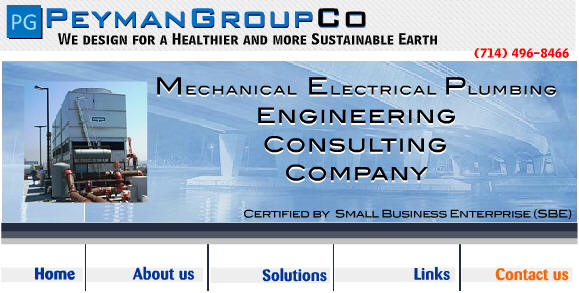 |
 |
|
|
|
Plumbing Design in California |
|
![Peyman Group [714] 496-8466 Mechanical Consultant Engineering in Orange County, CA](images/image_87.jpg) Peyman
Group designs plumbing systems according
to the client's needs and complies with
the current building and plumbing codes. Peyman
Group designs plumbing systems according
to the client's needs and complies with
the current building and plumbing codes.
We provide plumbing design services,
such as sizing water heating systems,
sizing
sump pump, and sewage ejectors,
subsurface drainage design, waste and
vent
systems, water distribution, natural gas
distribution,
rainwater
systems,
compressed air distribution, lubricant
oil distribution, grease waste systems,
grease interceptor, lint interceptor,
oil
water separator, pumps, booster
pumps, misting systems, condensate drain
pump, water heaters, generating details,
isometric and riser diagrams, preparing
cut sheets of equipment, fixtures, and
writing specifications. |
Please call
![Peyman Group [714] 496-8466 Mechanical Consultant Engineering in Orange County, CA](images/image_87.jpg) Peyman Group NOW to have
preliminary discussion about your plumbing
design project and
immediate assistance by our experts. Peyman Group NOW to have
preliminary discussion about your plumbing
design project and
immediate assistance by our experts.
We follow design rules and guidelines of ASPE
(American Society of Plumbing Engineers) in
accompany with the latest California Plumbing
Code (CPC) and California Building Code (CBC) to
our design to provide an adequate and cost
effective design for your project.
Your satisfaction is guaranteed on different
phases of your plumbing project by our precise
and cost effective design.
Please contact us
for initial assessment of your project. |
|
|
|
Some sample plumbing guidelines we follow in our
engineered plumbing designs are:
Design systems to be simple, durable, easy
to operate and maintain, with ready
accessibility for servicing, maintenance and
replacement.
- Contact each utility supplier to determine
the requirements for the most cost effective
service connection.
-
Specify and apply plumbing fixtures comply
with California State water conservation
standards, and guidelines and maximum flow as
follows:
a.
Water Closets: 1.28 gpf,
b.
Urinals: 1.0 gpf or preferably use
waterless urinals,
c.
Lavatory Faucets: 1.5 gpm,
d.
Showers: 2.0 gpm,
e.
Kitchen Sink Faucets: 2.0 gpm.
|
-
Obtain Industrial Wastewater Permits from
the City of Los Angeles Department of Public
Works, Bureau of Sanitation - Industrial
Waste Management Division for all
restaurants and fat, oil, and grease
generating facilities.
|
 |
-
Grease lines from the following fixtures in
a restaurant or cafeteria shall be connected
to the grease interceptor: three compartment
sinks, all hand sinks, prep sinks and mop
sinks, floor drains, floor sinks within the
kitchen preparation area.
|
 |
-
Indicate invert elevations of new sewer
lines at buildings, and locations where
sewer lines join and at property lines.
|
 |
-
Coordinate
sewer and underground piping routing and
invert elevations to clear any conflict with
building structure.
|
 |
-
Indicate sizes of existing utility lines on
the plans.
|
 |
-
Primary condensate drains from
HVAC units
shall be discharged into a receptor that is
approved by code and the local jurisdiction
in a manner that is in compliance with the
code requirements
|
 |
-
Size cold water piping, hot-water
circulating pump and piping for water
velocity not to exceed 5 feet per second for
hot and 8 feet per second for cold water.
|
 |
-
Provide pressure-regulating valves with
strainers when street line pressure is over
80 psig to reduce pressure to approximately
80 psig.
|
 |
|
|
 |
-
Emergency shower and eye wash equipment
shall be installed in the areas where eye or
skin irritants exist and must comply with
California Code of Regulations (CCR), Title
8 - section 5162.
|
 |
-
Install
emergency shower within 10 seconds of
hazard, on the same level as hazard and with
unobstructed travel path.
|
 |
-
Water
delivered to emergency shower shall be
tepid, almost 85°F with 30 psig pressure,
running constantly for at least 15 minutes.
|
 |
-
Identify
emergency shower location with highly
visible sign and well-lighted surroundings.
|
|
Our project Engineers guarantee your
satisfaction & peace of mind! |
|
|
|
|
|
|
|
|
|
Professional Engineering
Design Services |
More
Professional Services
|
|
|
|
|


